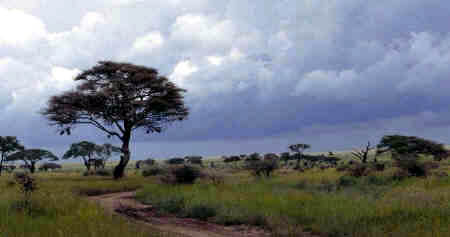Travel
Search
|
|
|
Harlan Hague |
Our safari seemed doomed from the start. February was supposed to be the best month. The short rains of December and January settle the dust and bring new grass, but not so high to hide the animals. But unseasonal rains--El Niņo, of course--had been so heavy that grass was high, and even 4wd vehicles were having a hard time on the roads and back-country of northern Tanzania. Then the eruption of Rift Valley fever appeared in the news. About the same time, I read reports of attacks on safari groups by armed bands.
Not to worry, Thomson Safaris told us. One of their groups had just completed a safari in the region where we were going, and they had a great time. The Rift Valley fever, they said, was limited to the Kenya-Somalia border country, and the attacks on safaris were isolated, rare, and far to the west of where we were going.
We set out, not without some apprehension. I had recruited members from California, Texas, Washington, Ohio, and a small village in Germany. We gathered in Amsterdam at the Canal House Hotel, a perfectly delightful 17th century hotel on the Keizersgracht canal in the old town. The next day, we flew together to Kilimanjaro airport. Our Thomson guides and drivers collected us and drove us to the Mountain Village Lodge on the outskirts of nearby Arusha.
After breakfast and a briefing the next morning, we were off. Our
vehicles were three Land Rover 4x4s. 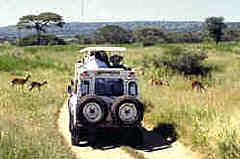 We stopped briefly in Arusha
to buy Tanzanian shillings and to visit the Cultural Heritage Center. Goods at the center
are high quality, but prices are also high. You'll likely find better bargains at roadside
shops in the countryside and in Arusha at the end the safari.
We stopped briefly in Arusha
to buy Tanzanian shillings and to visit the Cultural Heritage Center. Goods at the center
are high quality, but prices are also high. You'll likely find better bargains at roadside
shops in the countryside and in Arusha at the end the safari.
We arrived at Tarangire National Park in time for lunch at the Tarangire Tented Lodge. We were thrilled this first day with sightings of animals and birds. I knew that East Africa was known for its birdlife, but I was not prepared for the brilliant plumage and variety. I was particularly impressed with the Lilac-breasted roller and Fischer's love bird. The first elephants we saw gave me some little anxiety. They were browsing, then turned toward us and walked our way. Our driver was unconcerned, and I was reluctant to ask him to start the engine. The two elephants veered away and crossed the road thirty feet in front of us. I decided that our guide had been here before, so I would just sit back and enjoy.
We saw giraffes, herds of impala, mostly harems escorted by single bucks, ostriches, warthogs and Thomson's gazelles--no relation to our safari company--and a troop of baboons in a tree and on the river bed. Back in camp, we found a baboon sitting on our porch peering into our tent. What a nice mess we would have found if he had gone inside. Later a dikdik, Africa's smallest antelope, wandered through camp, and I saw an oryx on the river bank below the lodge.
Sunrise over the river valley was magnificent. After breakfast, we made
another rewarding "game drive"--the traditional and outdated term for wildlife
viewing--and returned to the lodge for lunch. Then we set out for Serengeti National Park.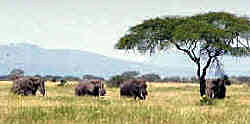 We could have arrived there easily by evening but for the condition
of the roads. They were abominable. The heavy red highway lines on the map lie. Holes and
ruts often were two feet deep. Standing water in low spots looked like hippo pools. We had
not seen a paved roadbed since leaving Arusha. I asked our driver if the unseasonal rains
were to blame for the bad roads. He replied that not all of them were this bad all the
time, which suggests that some of them were this bad most of the time. No wonder that
Thomson Safaris had warned the women to wear bras.
We could have arrived there easily by evening but for the condition
of the roads. They were abominable. The heavy red highway lines on the map lie. Holes and
ruts often were two feet deep. Standing water in low spots looked like hippo pools. We had
not seen a paved roadbed since leaving Arusha. I asked our driver if the unseasonal rains
were to blame for the bad roads. He replied that not all of them were this bad all the
time, which suggests that some of them were this bad most of the time. No wonder that
Thomson Safaris had warned the women to wear bras.
Because of the roads, we stopped the night at Kirurumu Tented Lodge. This is a pleasant camp on a plateau overlooking Lake Manyara, swollen by the heavy rains. Tents are widely spaced on permanent foundations. Like all the tented lodges, ours had an enclosed toilet and shower.
My wife and I had the tent at the end of the path. After dinner in the airy dining pavilion, we walked to our tent on the dimly-lighted path. We were scared out of our wits when a Masai warrior, steel-tipped spear in hand, stepped from the shadows into the middle of the path in front of us. We stared at each other. I pondered flight.
"Jambo," I said.
"Jambo," he replied, then stepped off the path. I learned the next day that he was the watchman.
After breakfast, we continued our drive to the Serengeti. The road rises in the Ngorongoro highlands until it reaches a viewpoint on the crater rim. Far below, we could make out elephants and buffalo. It was a teaser. We would return to the crater later.
Back on the road, we increasingly saw Masai, in their villages, tending
their cattle, and walking along the road. Most were going somewhere, but some were dressed
in their finery, waiting for tourists to 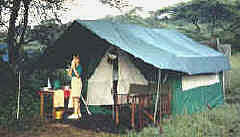 take their pictures for a fee. Indeed if you take their pictures without their
permission and payment, they become quite justifiably upset. Children are also often seen
on the road. Many wave, some few have the upturned hand, but most have their hands in a
writing gesture, as if holding a pen. At some point in the near past, some tourist gave
ballpoint pens to children, and now they look for pens from the tourists. Thomson Safaris
discourages giving gifts of any sort since it can encourage begging. They suggest instead
an exchange, say a pen for the privilege of taking a picture.
take their pictures for a fee. Indeed if you take their pictures without their
permission and payment, they become quite justifiably upset. Children are also often seen
on the road. Many wave, some few have the upturned hand, but most have their hands in a
writing gesture, as if holding a pen. At some point in the near past, some tourist gave
ballpoint pens to children, and now they look for pens from the tourists. Thomson Safaris
discourages giving gifts of any sort since it can encourage begging. They suggest instead
an exchange, say a pen for the privilege of taking a picture.
In the Serengeti, we were housed first at the Seronera Wildlife Lodge in the heart of the plain, then at a classic tented camp at Naabi Hill. We were originally scheduled for a longer tent camp, but fears of continuing rains suggested a shorter exposure to the potential discomfort of a sodden camp.
The Serengeti was all we expected. We saw lions, hippos and crocodiles, herds of buffalo, hyenas, a great variety of antelopes, ranging from eland, the largest, to dikdik, and herds of zebras and wildebeests that stretched from horizon to horizon. A guide estimated that one herd contained 300,000 animals. Another guide laughed and said that the herd could not number more than 200,000. We decided that it would be safe to call it a herd of a quarter million animals.
My favorite animal was the cheetah. We watched individuals, trim and sleek, and family groups of mother and young. When safari vehicles moved near them, they glanced toward them, almost haughtily, and lay down or slowly walked away, unconcerned, in control.
In addition to the better known large animals, we saw African wildcat,
silver-backed jackal, African hare, bat-eared fox, rock hyrax, various lizards, and a continuing array of exotic birds too numerous to list. But I must
mention the Kori Bustard, the largest flighted bird, the Secretary Bird with its
crest resembling a pencil behind the ear, and the stately Crowned Crane. Even the
starlings are colorful. The Superb Starling is a melange of orange, blue and green
metallic plumage.
a continuing array of exotic birds too numerous to list. But I must
mention the Kori Bustard, the largest flighted bird, the Secretary Bird with its
crest resembling a pencil behind the ear, and the stately Crowned Crane. Even the
starlings are colorful. The Superb Starling is a melange of orange, blue and green
metallic plumage.
An added pleasure of our Serengeti experience was a dawn balloon ascension. As the sun rose over the rocky outcrop of Simba Kopje (pronounced "copy"), our two balloons lifted and moved off over the plain. We rose hundreds of feet, then lowered to skim in the light breeze over the grass and trees. We saw some few animals, a cheetah sunning himself on a termite mound, bushbucks at a water hole, some Grant's gazelles, but mostly we enjoyed the wide vistas of grass and the pastel shades of the morning sky. On landing, we were met with the traditional champagne and a full English breakfast under an umbrella acacia, served on a linen-covered table by turbaned waiters. This is roughing it in grand style.
Leaving the Serengeti, we retraced our route through the Naabi Hill gate and visited Olduvai Gorge, a drive of about a half hour outside the park. As a light rain fell, we stood under a shelter overlooking the gorge, listening to a talk about the work of the Leakeys and others who found the remains of the ancestors of modern man. The small museum on the site houses copies of some of the finds and pictures of the archaeologists at work.
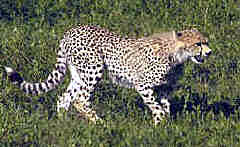 Back on the road, by prearrangement we stopped at a Masai village. The
government of Tanzania and the Masai people have wisely
designated villages where tourists are welcome to visit, for a fee of course. The cost for
us was $10 each. We were shown around the village and inside a house. Men danced and sang,
and villagers posed for pictures. We watched women repairing a roof with mud and dung.
Back on the road, by prearrangement we stopped at a Masai village. The
government of Tanzania and the Masai people have wisely
designated villages where tourists are welcome to visit, for a fee of course. The cost for
us was $10 each. We were shown around the village and inside a house. Men danced and sang,
and villagers posed for pictures. We watched women repairing a roof with mud and dung.
Articles made by the Masai were for sale in the village. My wife bought a spear. I suggested that it might raise eyebrows when she presented it at the KLM counter as her carry-on. Our guide translated, and the seller dismantled the sword into three pieces, breaking the wooden shaft in the process. They selected another, and he broke the shaft again. The third one was dismantled successfully.
When the head man's son saw me flailing wildly at flies on my arms and legs, he brushed them off with his whisk. I admired the whisk, which was made from a wildebeest tail and a beaded handle, and asked if he would sell it. He did, and I have never been more pleased with a purchase.
Our guide told me later about the Masai attitude toward the flies that swarmed about the village, villagers, and tourists. He said that the Masai claim that God, or the gods, gave all the cattle in the world to the Masai, and the flies come with the cattle. So they are tolerated.
On to the Ngorongoro Crater. We were originally due for a classic tent
camp here, but again we had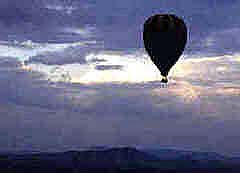 been rescheduled to avoid
the potential wet camp. We stayed at the Ngorongoro Sopa Lodge on the rim. The place was a
bit posh for me, but the view of the crater floor from the hotel terrace was wonderful,
and the sunset over the distant crater wall was spectacular.
been rescheduled to avoid
the potential wet camp. We stayed at the Ngorongoro Sopa Lodge on the rim. The place was a
bit posh for me, but the view of the crater floor from the hotel terrace was wonderful,
and the sunset over the distant crater wall was spectacular.
The Ngorongoro was the icing on the cake. We saw many of the same species that we had seen at Tarangire and the Serengeti, but there were unique experiences here as well. We saw our first rhino, whose numbers in the crater have been reduced by poaching to less than fifteen. We witnessed an incident that even our four guides had never seen: a face-down between a rhino and an elephant. A solitary elephant was walking slowly when he saw a lone rhino, standing quietly. The elephant changed direction and walked quickly toward the rhino. The rhino turned to face the oncoming elephant. When the elephant was about fifty feet from the rhino, he stopped. After a moment, he made a mock charge. The rhino lowered his head and stood his ground. The two were about twenty feet apart now. After a moment, the elephant turned and walked away.
Leaving the crater in late afternoon, we saw a herd of over thirty elephants grazing in a stand of small trees and stopped to observe them. As the driver shut off the engine, I heard a trumpeting behind us. I looked but saw nothing. After about ten minutes, we pulled away and turned up the road to continue. Suddenly, about thirty yards on our right, an elephant burst over a ridge and walked toward the road. He apparently was cut off from the herd that we had been watching. Our guide had stopped the car on sighting the elephant. The elephant saw us in his path and stopped. He swung his head back and forth and flapped his ears rapidly.
"I don't want to argue with this guy," our guide said, "he can turn this vehicle over." While the guide was trying to decide whether to go ahead or back, the elephant angled down the hill and crossed the road ahead of us.
The next day, after a half day of viewing on the crater floor, we drove
up the other side to reach the road toward Gibb's Farm where we would spend the 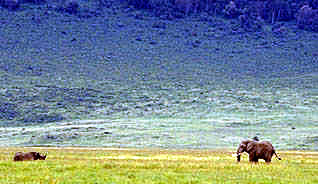 remainder of the day and night. We left Ngorongoro with some
reluctance since we had not during the entire safari seen a leopard. A compatriot and I
earlier claimed that we had seen a dozing leopard in a distant tree in the Serengeti, and
we agreed to confirm each other's sighting, but this arrangement didn't satisfy the others
in the group.
remainder of the day and night. We left Ngorongoro with some
reluctance since we had not during the entire safari seen a leopard. A compatriot and I
earlier claimed that we had seen a dozing leopard in a distant tree in the Serengeti, and
we agreed to confirm each other's sighting, but this arrangement didn't satisfy the others
in the group.
Then we were delivered. One of the guides said that he had seen a leopard in a tree just off the road. All three vehicles stopped, and we strained to see. The leopard rose from his limb, eased toward the trunk, then jumped to the ground. A fulfilling end to a great safari.
Gibb's Farm was a pleasant spot to relax and reflect. Established in the 1930s as a coffee farm, Gibb's now is a lodge, perfectly located as a way station between Arusha and the Serengeti and Ngorongoro. After a leisurely lunch and settling into our cottages, we sat on lawn chairs in front of the early-twentieth century converted farmhouse, enjoying tea and watching the birds at the plank feeder. Later we would sip wine while admiring the view of the valley below and watch the sun set over the distant hills. Highly recommended.
The drive to Arusha the next day was jolting and anti-climactic. We stopped again at the Cultural Heritage Center for shopping. In Arusha, we had day rooms at the Mt. Meru Hotel where we showered and lunched. Some of our members swam in the hotel pool. Others went into Arusha for shopping and sightseeing. My wife found bargains in carved animals and wall hangings at the Kase Bookstore on Boma Road. I bought a bird book and maps at the same store. Recommended.
We were among the first to arrive at the airport for the KLM evening flight, thus avoiding long check-in lines. There are a snack bar and a tourist shop in the waiting area. The restaurant upstairs was open for business, but had no patrons.
We had met guides and drivers at the airport two weeks ago; now we said goodby to friends: Little John, driver; Jonas, driver/guide; Frank, guide; and John, driver/guide and leader of the group. I recommend them all without reservation.
Arrangements for our February 1998 tour were ably handled by Thomson Safaris, with offices in the U.S. (347 Broadway, Cambridge, MA 02139; 800/235-0289; email: Tsafari@aol.com) and Tanzania. Our tour was priced at $4,390 from San Francisco. For information on the balloon safari, contact Michael Toogood, Serengeti Balloon Safaris, Ltd., Unit D9, Harleston Industrial Estate, Harleston, Norfolk, IP20 9EB, UK, tel. 01379 853129, fax 01379 853127, email: 101507.1463@CompuServe.COM. The balloon ascension was $295. For Gibb's Farm, write to Arusha Booking Office, P.O. Box 6084, Arusha, Tanzania, tel. 057-6702/8930 and 3181, ext. 1487, fax 255-57-8310, email: ndutugibbs@habari.co.tz .
This article appeared in International Travel News, February 1999.
|
Caveat and disclaimer: This is a freelance travel article that I published some time ago. Some data, especially prices, links and contact information, may not be current. |
|
|
|
|
